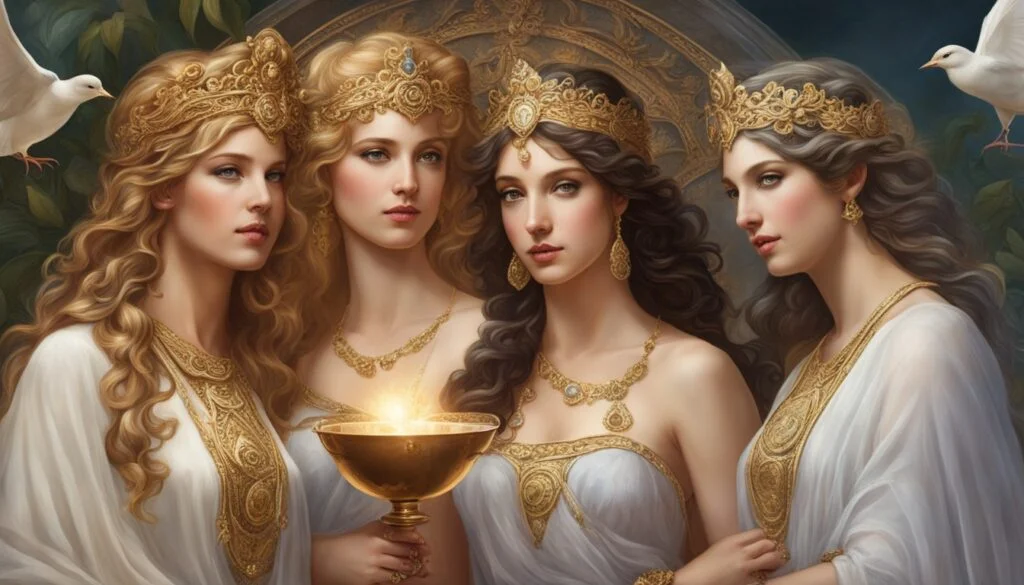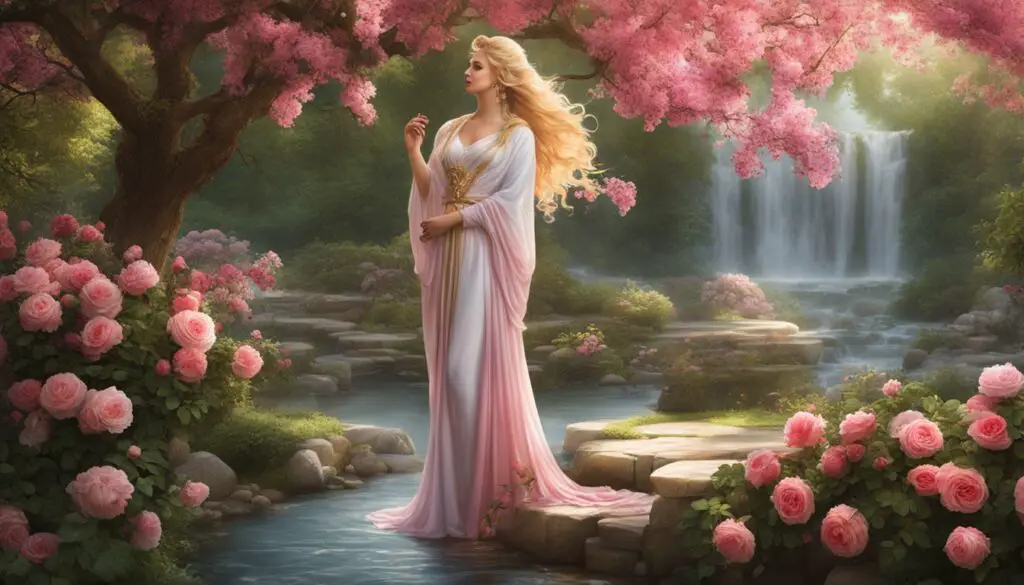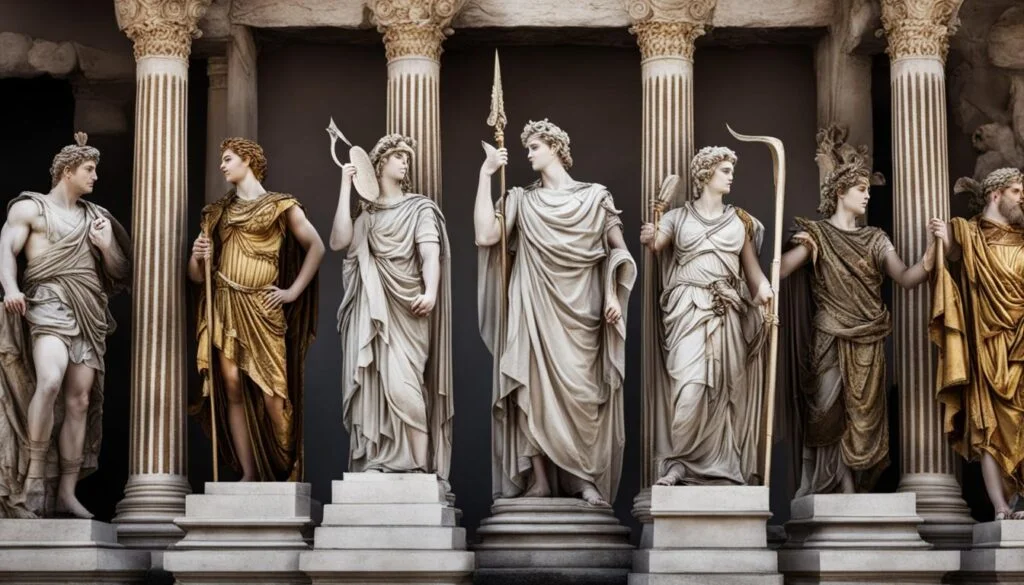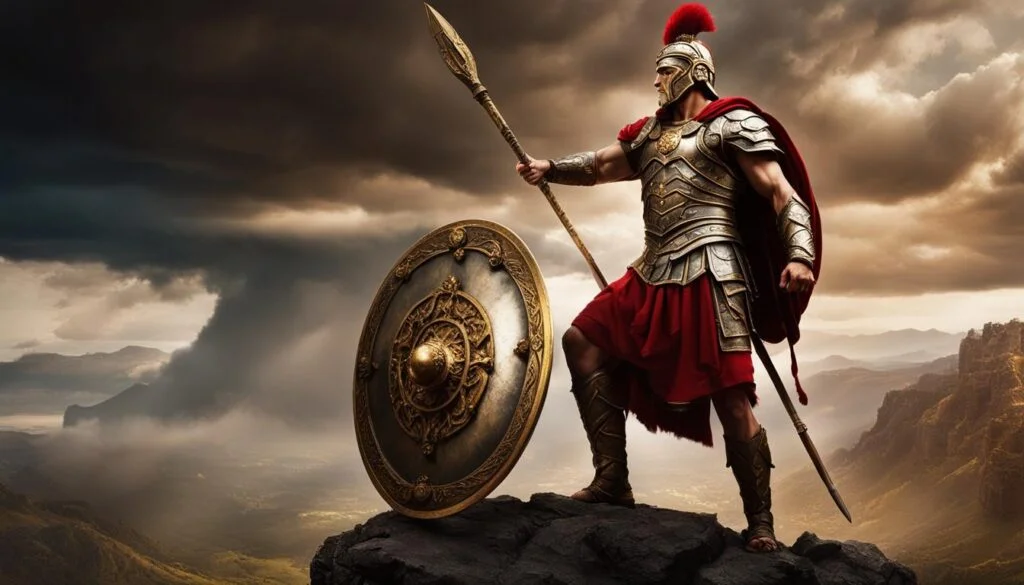In Roman myths, Venus is a powerful figure. She is the goddess of love, beauty, and yearning.
Venus was born all at once, coming from the sea’s foam. This gorgeous goddess had a huge impact on Roman life and culture.
Venus was not just beautiful; she was essential to Romans. As the goddess Venus, she ruled over many things.
This included making things grow, wealth, and even winning in battle. Through her son Aeneas, she became the Romans’ blessed ancestor.
Aeneas survived Troy and made his home in Italy.
Venus was not only about beauty and love. She was also a key part of Roman celebrations and was celebrated in many ways.
From being known as a mother to a bearer of victory, Venus was everywhere in Rome’s daily life.
Key Takeaways
- Venus was born from sea foam in Roman mythology
- She embodied love, beauty, fertility, and victory
- Romans claimed Venus as their divine ancestor
- Venus played a central role in Roman religious festivals
- She was worshipped under various titles reflecting her diverse aspects
- Venus’s influence extended to Roman art and literature
Who Was Venus in Roman Mythology?
Venus was the Roman goddess known for love and beauty. She was key in the Roman gods.
Known for her link to love and beauty, the story of her birth is unique. Venus came to be from the sea’s foam after Saturn cut off Uranus’s genitals.
Origins and Functions of Venus
In the early days of Rome, Venus wasn’t a main figure. But, she grew in importance as powerful Romans like Julius Caesar and Emperor Augustus honored her.
Venus came to be linked with love, beauty, and nature. She also became a symbol of seduction and lust, reflecting Roman views on love and sex.
Venus as Ancestor of the Roman People
Venus was seen as the mother of the Roman people. This view came from her love affair with the prince Anchises, producing Aeneas.
Aeneas, as Virgil wrote, founded Rome. This made Venus a central ancestral goddess. Notably, leaders like Julius Caesar used this connection to claim they were divine descendants of Venus.
Significance in Roman Religion and Festivals
Venus was very important in Roman worship and festivities. The building of the Venus Genetrix temple during the Second Punic War in 217 BCE is a good example.
This temple highlighted Venus’s role in both peace and war in Roman minds. She was believed to influence not just love and beauty but also the outcomes of battles.
The Etymology of Venus
The name Venus has deep roots in ancient Roman culture. It comes from a Proto-Italic word that means “desire. ”
The Latin word “venus” means “love” or “charm.” This shows the goddess’s role in love and charm in Roman mythology.
Venus’s name links to many Latin words:
- Venustus: attractive or charming
- Venustas: grace or charm
- Venerius: related to love or Venus
- Venerare: to worship or honor
What’s more, Venus is connected to other Latin terms. It shares roots with “venia” (favor or permission) and “venor” (to hunt).
These links show the many roles Venus played in Roman society.
Venus’s name isn’t just for the goddess. It’s also the name of the brightest planet we can see.
This links the goddess to the heavens, adding to venus mythology. It connects the human world with the divine.
Even today, Venus’s name is remembered. The symbol for a female is Venus’s hand mirror.
It’s a lasting sign of the Roman goddess of love and beauty.
Venus in Roman Pantheon: Roles and Attributes
Venus was more than a goddess of love and beauty in the Roman world. She played many roles. People sought her help for matters of the heart, fertility, and even war victory.
Goddess of Love, Beauty, and Desire
Venus symbolizes love and physical beauty. This inspired brands, like Gillette with their Venus products.
Her image influenced cosmetics and beauty ideals until modern times.
Symbol of Fertility and Prosperity
Venus was key in bringing luck and riches. The Romans celebrated her on April 1st at the Veneralia festival.
This was a time to ask for her help against evil and for fertility. She was especially important for families and farmers.
The Victorious Aspect of Venus
But Venus also had a surprising connection to wars. People prayed to Venus Victrix for victory in battle.
Pompey even built a temple for her in 55 B.C.E. This highlighted the belief that Venus could help in both love and war.
Venus’s many roles made her very important in Roman life. Her influence was found in beauty practices and military strategies.
She showed how complex and central deities could be in ancient societies.
Venus and Greek Aphrodite: Similarities and Differences

Venus and Aphrodite are key figures in mythology, representing love, beauty, and desire.
The Romans tied Venus closely to their culture. They borrowed Aphrodite’s tales from the Greeks, adding them to Venus’s story.
Venus played a larger role in Roman religious life than Aphrodite did in Greece. She was seen as important for imperial power and the origin of the Roman people.
Aphrodite and Venus’s link was established early in Roman history, thanks to shared traits with Jupiter.
Both were honored in festivals, Aphrodite with Aphrodisiac and Venus with various Rome events.
Romans believed they could reach godly ideals, which affected the way they worshipped Venus. Greeks, on the other hand, saw gods as distant and untouchable.
- Venus was Julius Caesar and Augustus’s protector.
- Aphrodite was known for her many divine and mortal partners.
- They were both connected to gardens and fertility.
The connection between Venus and Aphrodite shows how the Romans and Greeks shared and evolved their cultural beliefs.
While they had common traits, their differences highlight unique aspects of their societies.
Iconic Representations of Venus in Art
Venus is the Roman goddess of love and beauty. Her image has inspired countless artists over time.
She appears in many of the most famous pieces, captivating all who see her.
Famous Sculptures of Venus
The Venus de Milo is one of the most famous sculptures of Venus. It was made between 130 and 100 BCE in ancient Greece.
The statue stands 6′ 7″ tall, showing the goddess in her nude form. This symbolizes the ancient ideal of female beauty.
Venus in Renaissance Paintings
The Renaissance period brought a new love for classic themes. Venus was a main focus in many of the great works.
A key example is Sandro Botticelli’s “The Birth of Venus.” This painting, from 1485, features Venus coming from the sea on a shell.
The Birth of Venus changed the art world. It was the first large-scale nude figure of Venus in Western art for many years.
The painting mixes old myths with new ideas. It shows Venus as the ultimate symbol of love and beauty.
Symbolic Elements in Venus Imagery
Artists often use certain symbols to show Venus in their work. These include:
- Seashells, for her birth from the sea foam
- Roses, as a symbol of love and beauty
- Doves, her special birds
- Mirrors, showing her divine beauty
These symbols make it easy for people to recognize Venus. They help show her role as the goddess of love and beauty in Roman myths.
The Mythology of Venus: Key Stories and Legends
The Venus mythology is full of captivating stories. She’s the goddess of love and beauty.
The story of Venus’ birth is especially intriguing. She emerged from sea foam, beautiful and fully grown.
This unique entrance marked her importance in Roman religion.
Venus’ role in many myths is crucial. She had love affairs with gods and humans, leading to many stories.
A well-known tale is her romance with Mars, the war god. Their relationship highlighted love and war’s connection in Roman society.
In Rome’s founding myth, Venus is key as Aeneas’ mother. This link to divine heritage increased her stature.
It made her a guardian deity of the Roman people.
- Venus emerged from sea foam
- She had affairs with gods and mortals
- Her son Aeneas founded Rome
In many tales, Venus is a powerful figure. She influences love, starts wars, and changes lives.
These stories taught Romans about love, beauty, and the complexities of relationships.
Venus in Roman Culture and Society
Venus was a key figure in Roman culture, known for love and beauty. She shaped not just myths but daily life and social rules in ancient Rome.
The way people got married, what they wrote, and even politics were influenced by her worship.
Marriage and Family Life
In Roman marriage traditions, Venus had a big influence. Before weddings, brides gave gifts to Venus for luck.
Venus Verticordia protected women’s purity, highlighting her social and moral role.
Literary Influence
Venus was a common theme in Roman literature and poetry. Poets such as Virgil and Ovid wrote of her, adding depth to their work.
These tales brought fun and reconfirmed cultural viewpoints about love and beauty.
Famous Temples and Cult Sites of Venus

Venus was a big deal in ancient Rome. She had many temples in the Roman world. The Temple of Venus and Roma, at 41°53’27″N 12°29’23″E, was especially important.
Emperor Hadrian started it in 121 AD. By 135 AD, it was ready for worship. It was thought to be the biggest temple in all of Rome.
Over time, this temple faced many problems. In 307 AD, a fire damaged it. This led to a repair by Emperor Maxentius.
Later, it had to close when pagans were being treated badly. It reopened but was again closed in 630 AD by Pope Honorius I.
Its fancy roof tiles were taken to decorate St. Peter’s. Finally, an earthquake in the 9th century probably destroyed it.
- Temple of Venus Erycina on the Capitoline Hill (215 BCE)
- Temple of Venus Genetrix in Julius Caesar’s forum (46 BCE)
- Temple of Venus Victrix in Pompey’s theatre (55 BCE)
Venus’ worship wasn’t just in Rome. In Elis, Greece, there were many temples to Aphrodite.
Arcadia had its share too. They even had wooden statues of the goddess. The Romans honored Venus with events like Veneralia on April 1.
They also celebrated Vinalia Rustica on August 19. These festivals marked the different roles Venus played and how special she was to Roman culture.
Venus and Her Relationships with Other Roman Deities
In the Roman pantheon, Venus was the goddess of love and beauty. She had complex relationships with other deities.
Venus married Vulcan, the god of fire and metalworking. But, she also had a passionate affair with Mars, the god of war.
This mix of love and war made her stories intriguing.
Venus was also the mother of Cupid, the god of desire. Cupid used magic arrows to make people fall in love.
The goddess had a connection to Bacchus, the god of wine and revelry. They were often shown together, symbolizing the link between love and celebration.
As Venus Caelestis, she joined with foreign goddesses too. This included the Syrian deity and the Roman Magna Mater.
Such mergers expanded her role in the Roman pantheon. Venus had a connection to Cloacina as well, an Etruscan water goddess.
These varied relationships show how important Venus was in Roman divine stories.
Frequently Asked Questions
Are Venus and Aphrodite the same?
Yes, Venus and Aphrodite are the same in terms of their roles and attributes in mythology. Venus is the Roman goddess of love, beauty, and fertility, equivalent to the Greek goddess Aphrodite.
Is Venus the daughter of Jupiter?
In Roman mythology, Venus is not typically considered the daughter of Jupiter. According to one version of the myth, she was born from the sea foam. However, in some stories, she is referred to as a daughter of Jupiter.
Who did Venus fall in love with?
Venus fell in love with several figures in mythology. Most notably, she had a love affair with the mortal Adonis and was married to Vulcan (Hephaestus in Greek mythology), the god of fire and blacksmiths. She also had a notable affair with Mars (Ares in Greek mythology), the god of war.
How is Venus related to Zeus?
Venus is not directly related to Zeus in Roman mythology. However, her Greek counterpart, Aphrodite, is connected to Zeus. In one version of Greek mythology, Aphrodite is considered the daughter of Zeus and Dione.
What does Venus symbolize?
Venus symbolizes love, beauty, desire, fertility, and prosperity. She is often associated with romantic attraction, artistic expression, and the generative forces of nature.
What is the sacred animal of Venus?
The sacred animals of Venus include the dove, swan, and sparrow. These birds are often associated with love and beauty, reflecting Venus’s attributes and her connection to nature and fertility.




